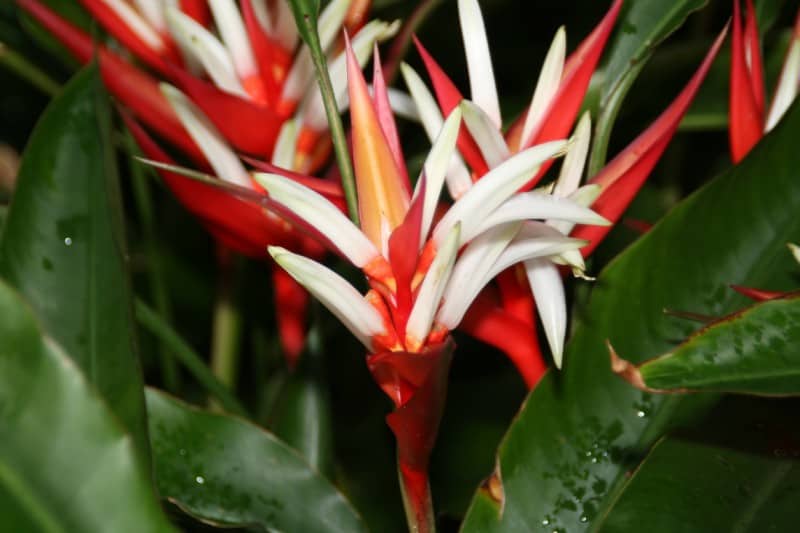
Christmas Heliconia Facts
- First of all, the quite gorgeous Christmas Heliconia derives its name from its appearance and time of blooming. This amazing fact holds true due to one of those coincidences that sometimes occur in Nature. That’s because this unique botanical beauty typically blooms around the Christmas season.
- In addition, the timing of its blooming combines with its own rather beautiful patterns of color. This consists of vividly red and white flowers that combine to generate a truly marvelous characteristic. Quite understandably, these two factors directly led to its distinctive common name.
- Rather unfortunately, however, the IUCN also recently listed the Christmas Heliconia on its Red List of Threatened Species. There, this plant classifies as Vulnerable. This unfortunate status occurs due to the fact that most of its natural habitat has now been converted by humans to farmland.
- Furthermore, the species now appears to also be quite rare in the wild in its endemic range. However, it also remains extremely popular in many portions of the world as a garden or ornamental plant. Therefore, for the moment, the future of the species seems fairly bright.
- We sincerely hope that its popularity serves to prevent its complete extinction as a species. However, fears also exist that the species will soon become extinct in its natural environment. There, it faces several dangers. But the primary threats it faces there include habitat loss and climate change.
Related Articles
Rosy Periwinkle Hooker’s Lips Amazon Lily
Christmas Heliconia Physical Description
Perhaps the most notable fact about the supremely gorgeous Christmas Heliconia remains the fact that it evolved as a tropical species. Furthermore, the plant evolved a surprising trait in its hardiness. Despite its seemingly sturdy construction, however, botanists classify the species as a delicate perennial.
Firstly, the plants themselves typically grow relatively large, at least compared to related species. That’s because individual specimens typically attain a height of between 6-8 ft (1.8-2.4 m). Secondly, though, the foliage it develops appears as evergreen, and the leaves typically have a rather leathery texture.
Further, the most commonly produced color combination remains the memorable primarily red and white. Not surprisingly, this pattern represents the one for which it remains best known, even today. However, other colors also appear occasionally. These variations most often include yellow and orange.
The natural wonder of Nature also distinguishes itself in yet another remarkable manner. This holds true due to the fact that in the wild, the Christmas Heliconia reproduces via seeds alone. Yet, in cultivation, the amazing Angiosperm also reproduces via root propagation, increasing its versatility.
- Kingdom: Plantae
- Phylum: Angiosperms
- Class: Monocots
- Order: Zingiberales
- Family: Heliconiceae
- Genus: Heliconia
- Species: H. angusta
Photographer: Björn S
CC License: http://bit.ly/2xLZ0ap
Christmas Heliconia Distribution, Habitat, and Ecology
Not surprisingly, the magnificent Christmas Heliconia evolved as endemic to a decidedly warm and quite lush environment. In fact, this beauty only appears naturally in a rather restricted portion of the world. This fortunate area consists solely of the southeastern portion of the country of Brazil, in South America.
As one might expect, within its native environment, the plant typically inhabits regions of the lush tropical forest. It also bears one trait in common with many closely related species. That’s because this marvelous Angiosperm variety grows best in the primarily warm, moist conditions found there.
Yet, to the astonishment of some, many individual plants often appear to be rather adaptable to highly variable conditions. That’s because most specimens observed also grow well in either full sun or moderate shade. Further, the majority of plants produce the now famous flowers, regardless of the region it grows in.
Finally, this remarkably impressive species also plays an important role in its native habitat. There, the plant quite frequently serves as a shelter for numerous types of bats native to the region, along with several other animals. It also serves as a major food source for many varieties of hummingbirds.
Species Sharing Its Range
Check out our other articles on 6 Mysterious Natural Phenomena, Atlantic Trumpetfish, Bungle Bungles, Ascension Island Parsley Fern, Vampire Moth, Olive Ridley Sea Turtle

